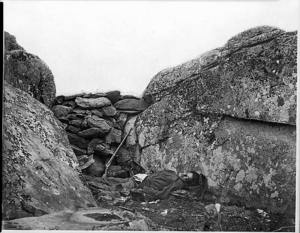In July of 1863, Confederate General Robert E. Lee led his Army of Northern Virginia towards a small town in central Pennsylvania, determined to force a truce from the Union by a bold, unprecedented invasion of the north. His chief adversary was Major General George G. Meade, whose Army of the Potomac consisted of 95,000 soldiers. In its second bloody year, the Civil War had devastated much of Lee’s home state of Virginia. Lee’s move was a risky one, but if successful, could potentially save thousands of lives in the long run.
The assault failed to secure a Confederate foothold in the north, but in its wake left behind a rich historical legacy of struggle and sacrifice that endures to this day, and supposedly, also left behind legions of ghosts.
The area of the 6,000-acre battlefield reputed to be the most haunted is Devil’s Den, formed by a sprawling bunch of granite boulders about half a mile across from a hill known as Little Round Top, to the south of town. True to its name, Devil’s Den was the scene of some of the fiercest fighting at Gettysburg. On the second day of the battle, July 2, Union artillery positioned among the huge stones rained withering fire on the advancing Confederates.
The southern forces who swarmed the Union position from all sides at Devil’s Den suffered tremendous casualties. The boulders obscured the attackers’ visibility, and many were cut down by enemies lurking in the crevices. Eventually, the Confederates managed to take Devil’s Den, and used the rocky outcropping to take shots at the Federals stationed on Little Round Top. One infamous sniper took out dozens of Union troops before he was killed by an artillery round.
Devil’s Den got its name long prior to the battle, but no one is sure exactly how. There were apparent ghost sightings there even before the conflict, and unsubstantiated reports of monsters lurking in the rocks. In the decades following those three deadly days in July of 1863, reports of paranormal activity have increased exponentially. Sounds of hoof beats mix with the cries of dying men, and silhouettes dart in between the boulders. Photographs taken show strange orbs of light, and amorphous, swirling forms.
Many visitors have glimpsed an apparition that resembles the typical Texan infantryman of 1863, rough and ragged. He appears briefly, sometimes gesturing or motioning, but never speaking a word. Some speculate that he is the aforementioned sniper who harried the Federal troops on Little Round Top. Another theory centers around a famous photograph which shows a dead Confederate soldier lying supine next to one of the boulders at Devil’s Den. This shot was staged three days after the battle by a photographer who dragged the corpse into position. Supposedly, the dead man’s spirit resents this disrespectful treatment (Suite101.com). Who this phantom soldier is, or if he is, will probably never be known. But given that over 50,000 men died in that fateful battle, he could be almost anyone.
Sources
Gettysburg.com. 11 Oct. 2007
Devil’s Den.” National Park Service 11 Oct. 2007
“Devil’s Den.” Wikipedia. 11 Oct. 2007
Popola, Jaclyn. “Gettysburg Battlefield, PA- Devil’s Den.” HubPages 11 Oct. 2007
“Devil’s Den, Gettysburg.” Suite101™.com 2001. 11 Oct. 2007.
